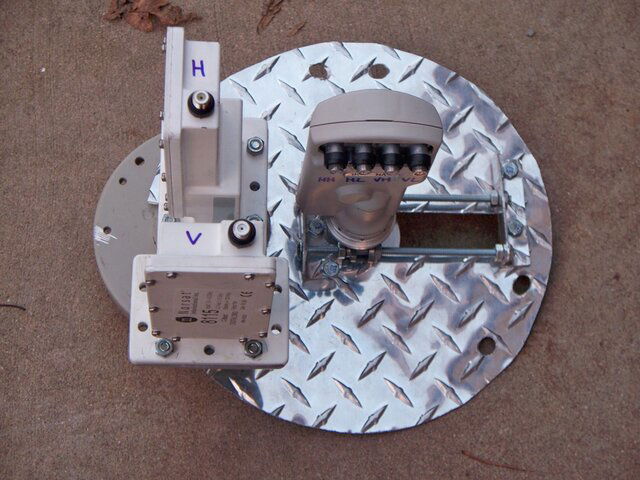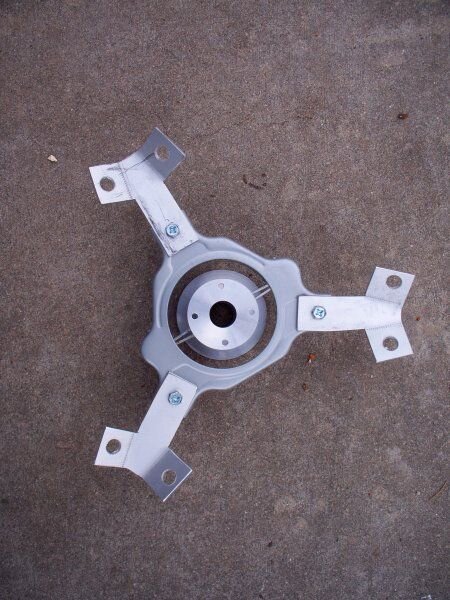BV Scalar:
- did you determine if it under illuminates, as you suspected?
- was that on C-band, Ku, both?
- does it have any noticeable TI rejection, and is that even necessary any more?
- any clue why it's so big?
I have the C-band illumination where I want it, however adjusting this on any dish is at best a compromise. To maximize signal gain, you want to illuminate as much of the dish as possible. To minimize thermal noise you want to the feed's polar pattern response to be well down by the dish's rim. Reception is normally dictated by the ratio of these two, so tuning the illumination (sometimes referred to as setting the f/D) is often best accomplished by maximizing CNR. But this will be dependent on where one points the dish, because earth noise and rim rejection varies with elevation.
Because the Ku illumination cannot be easily adjusted independently with dual ortho feeds, the most accurate statement I can make is the Ku dual ortho setup on a Birdview is losing at least 2 dB from where it ideally would be, and almost certainly more. Resolving this more precisely would take a lot of futzing around and realigning multiple dishes using different feeds and LNBs. I had hoped to try a bit of this, but then I got buried with other projects and demands on my time.
Some of the Ku loss is from the extended length of the dual ortho Ku waveguide. This is common in one manner or another to all dual orthos and corotors. Another common attribute for both types is the Ku feed lacks an effective scalar. My expectation is the Ku beam pattern is not well behaved and narrower than desired. These are interrelated and physical measurement with the equipment I have would be fairly difficult. Setting up a simulation would be the best way to get a theoretical handle on this, but I would only go to the trouble if I were contemplating modifications to the feed to improve the beam pattern.
Scalars provide a number of benefits, including the alignment of the fields, better pattern control and rear lobe rejection. A larger scalar is easier to model and should provide better E&M characteristics. Of course the bigger it is the more shadowing it causes, but that's a very miniscule effect for typical dish/scalar dimensions. I presume smaller scalars came about because the performance loss is small compared to the reduction in fabrication costs.
TI rejection can be enhanced by better scalars, but for the most part is a dead issue. Saturation by out-of-band interference (typically radar) is possible although rarely observed. I can see the presence of these signals on my spectrum analyzer, but I haven't seen any evidence of reduced reception margins for any of my dishes.
Ku performance:
- was the ortho an ADL as I've seen you describe before, with an extension tube for Ku to an Invacom quatro LNB?
- (quote on Ku f/D for dual-band Orthos) what was the theory?
- (quote on using exotic techniques to improve Ku performance) just what did you mean by that? Your standard equipment seems pretty exotic.

The dual ortho is the same ADL Frankenstein unit seen many times in my posts (stock C-band with custom transition to an Invcaom universal quatro LNB). Since I've measured this combination on all of my prime focus dishes, each with a different f/D, I have conclusive data that show the Ku loss goes down with increasing f/D. That's indicative of a narrow Ku beam compared to the easily measured C-band beam. Again this would ideally be modeled, but looking at the feed geometry suggests the Ku side has a f/D in the neighborhood of 0.4-0.5. It is definitely not less than 0.4, but without better equipment or a higher f/D dish, I'm merely setting a comfortable upper bound.
To answer the 'exotic' question, I have toyed with modifying the dual ortho to improve Ku-band reception without compromising C-band. The first step was to get a higher f/D dish, like the Birdview. Not all the mods I've contemplated would be reversible, so I'm reluctant to make any without running the theory first.
As I mentioned earlier in the thread, it would be interesting to compare the dual ortho Ku performance against a Ku only feed. I own an Invacom ADF-120 that I modified for an adjustable f/D over the range of about 0.27-0.50 (the stock feed is adjustable, but over a much smaller interval). But this would require a significant adapter to mate with the Birdview struts and be a complete throwaway, because I have no intention of making the Birdview Ku-only. I have considered building a prototype plate to try running the Invacom off-axis with a proper Ku scalar. If this proved to be higher performing on Ku than the dual ortho, which I suspect it would, I could then modify a single C-band ortho to incorporate it. This also should restore part of the C-band loss I've measured on dual orthos.
Motor System:
- after all the pulse-doubling of the Xor circuit and Gbox, how many counts per rotation of the worm gear?
... best I could figure: DIP set to 48 pulses, Xor does times two, Gbox does times two, equaling 192?
- so, even with no Xor pulse doubler, and no Gbox pulse doubling, one could set the encoder to 192 and get the same results?
...of course, we don't know if other Vboxes would count plus or minus 9999 (and likely wouldn't)

- Birdview dishes came with perhaps three motors.
...Which one is on yours?
Gear ratios were something like 48:1, 75:1, or 110:1 as best I remember.
- how many pulses per what? Is this your previous 192 (200) overall pulses per turn of the worm?
There are 192 pulses per revolution of the worm gear, as you have calculated. This corresponds to an approximate 1:120 ratio for the worm/half-moon gears. I don't know the gearing reduction inside the motor housing. I vaguely recall trying to make out the markings on the motor, but my fairly extensive notes from the project show nothing recorded. When I read your question 1:37 came to mind, but this must be regarded with extreme skepticism, coming from an aging and rotting mind filled with countless numbers from a bizarre range of unrelated sources.
One could achieve the 192 shaft count by deleting the XOR gate and adjusting the encoder DIP switch as you suggest. I chose the XOR approach because the pulses are in quadrature.
Spun Aluminum Dish:
- you said you repainted it? What did you use?
- I might have gone for a less-white color, as I don't enjoy the attention it attracts.
... unfortunately, mine is fine with original paint/finish, so no excuse to repaint.

- Any idea if it's powder coated?
The original paint was badly weathered and coming off as thick dust. The Birdview logo was only visible as a faint shadow. I suspect this was an older dish showing UV deterioration in the hot Colorado high-altitude desert sun, in a fairly pollution-free environment. I have no idea what type of paint and/or coating was originally applied because of this. In a gesture of kindness to my neighbor jerk (only one, the others are more tolerant), I painted the Birdview the same color as our house with leftover paint. You can see a picture (the one with the three toroids) earlier in the thread for the color; it's pretty close on my computer monitor. The dish doesn't blend in perfectly because of its location, but certainly stands out less than the off-white it could have been.
Here's something I was thinking about for new Birdview owners.
Maybe simpler way to do the conversion ...
- use standard scalar ? Should fit the ortho feedhorns better.
- replace 6-legs with three conduit or anodized aluminum legs
- scalar could still be floated toward the dish on big bolts +washers or +nuts to fine tune focus, if necessary.
- or do you favor the 6-leg design and odd scalar?
I had considered an approach along similar lines, but thought it would take more effort, with nothing much to show for it. It took less than an hour to cut and thread the struts, although in fairness one was broken off in the dish. Dealing with that was easy. The most tedious part was enlarging the scalar's feed hole. With the right equipment this would have taken only a few minutes, but that would have required driving somewhere. I could have constructed a jig, but that would have also taken time. As this was a simple one-off, hand filing seemed in order and was complete in about 30 minutes. I stopped a lot to check with calipers.
The six-strut design is quite rigid and that is a serious consideration with the winds, here. Even with one strut broken when I rescued the dish, there was no play or slop. If I were changing feeds and scalars a lot, I could better see the logic of a more standardized support, particularly with fewer struts. But because I chopped an existing scalar to use as a clamp on the backside of the Birdview scalar, it is trivial for me to remove and swap any standard C-band feed. I did want to retain the Birdview scalar. While I haven't modeled it against a typical modern scalar, my prior experience says it should perform better.








